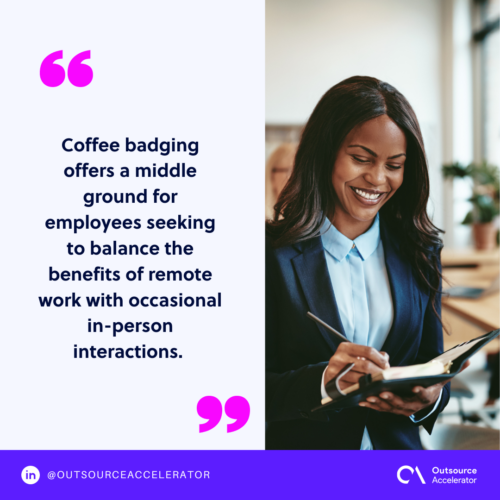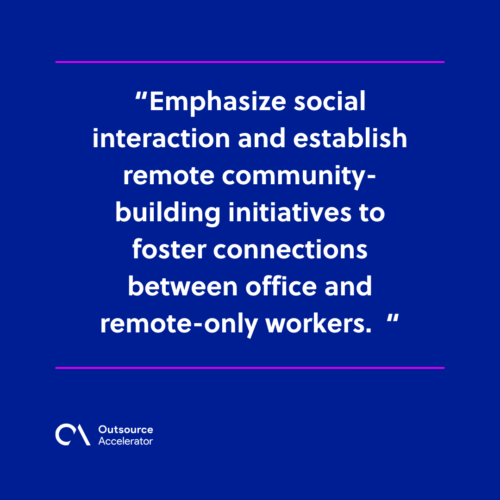Understanding the basics of coffee badging

It’s now been a few years since the world has returned to relative normalcy after the COVID-19 pandemic, and companies are navigating the return to the traditional office environment.
Meanwhile, employees are seeking ingenious ways to balance the demands of in-person attendance with the newfound freedom of remote work.
One such practice is “coffee badging.” This unconventional approach has become a creative camping mechanism for those grappling with in-office mandates.
This article looks at the intriguing trend of coffee badging, uncovering its roots and implications for the evolving dynamics of the workplace.
What is coffee badging?
Coffee badging is a practice in which employees physically show up at the office, but often only for a brief period, to fulfill attendance requirements. They primarily do this by scanning their security badge before promptly leaving to work remotely or elsewhere.
This innovative strategy has gained momentum as a means for workers to comply with in-office mandates while retaining the flexibility of remote work.
The rise of coffee badging reflects the evolving dynamics of the modern workplace as employees seek to navigate the transition back to traditional office settings.

5 causes of coffee badging
Employees engage in coffee badging for various reasons, driven by a combination of personal preferences, practical considerations, and organizational dynamics.
Here are some common motivations behind this practice:
1. Meeting attendance requirements
Coffee badging allows employees to fulfill the visual presence requirements set by their companies without necessarily committing to a full workday in the office.
Employees can demonstrate compliance with in-office mandates while still retaining remote work flexibility. They’ll simply need to scan their security badge or attend a required on-site meeting.
2. Access to resources
Some employees engage in coffee badging to access specific resources available in the office environment, such as:
- High-speed internet
- Specialized equipment
- Company-sponsored amenities
Briefly visiting the workplace allows employees to leverage these resources for increased productivity or networking opportunities before continuing their work remotely.
3. Networking and socializing
Some individuals value workplace connections and interactions despite preferring to work at home. Coffee badging provides an opportunity to engage with colleagues, build relationships, and participate in impromptu discussions or brainstorming sessions.
Employees can foster a sense of camaraderie and maintain social connections without committing to full-time in-office work.
4. Perception management
Engaging in coffee badging can also be a strategic move to manage perceptions of commitment and engagement within the organization.
By physically showing up at the workplace, employees signal their presence and participation, which may influence how managers, colleagues, or stakeholders perceive them.
This practice can help employees navigate organizational politics and demonstrate their dedication to the team.
5. Balancing work and life
Coffee badging offers a middle ground for employees seeking to balance the benefits of remote work with occasional in-person interactions.
With short office visits as part of the routine, employees can maintain a sense of work-life balance. They can structure their day effectively, and transition between different modes of work seamlessly.

Impact of coffee badging on the workplace
Exploring the practice of coffee badging reveals both positive and negative impacts on workplace culture, productivity, and employee morale.
Here is a summary of both:
Positive effects
Those who support coffee badging will attest to these positive effects:
- Enhanced productivity and focus – A coffee badging break can provide a mental refresh and boost employee energy levels, potentially leading to improved focus and productivity.
- Promotion of social interaction – Coffee badging allows employees to interact with colleagues, engage in informal conversations, and build relationships that can enhance teamwork and collaboration.
- Boost in employee morale and engagement – Social interactions during coffee badging can foster a sense of community, promote workplace relationships, and contribute to higher levels of employee satisfaction and engagement.
- Facilitation of accountability – Regular visits for coffee badging can create a sense of accountability as employees are required to physically show up at the workplace, thus encouraging adherence to work expectations.
Negative effects
Meanwhile, those against the practice cite these negative effects:
- Disruption of remote work routines – Frequent disruptions caused by coffee badging may hamper employees’ established remote work routines, potentially leading to decreased productivity and an inability to focus during office hours.
- Inequality and exclusion – Coffee badging may create a divide between employees who have the option to visit the workplace and those who do not. This can lead to feelings of exclusion and inequality among remote-only workers.
- Increase in workplace distractions – When employees visit the workplace for coffee badging, they may encounter more distractions than in their remote work environment, impacting their ability to concentrate and be productive.
- Health and safety concerns – Physical presence in the workplace during coffee badging may expose employees to health and safety risks, especially if proper protocols and precautions are not observed.
How to manage a positive workplace amidst the rise of coffee badging
Maintaining a positive workplace as coffee badging increases involves tackling its challenges while encouraging a supportive and productive environment.
Here are some strategies to manage this:
Establish clear communication channels
Employees who participate in coffee badging must understand the expectations regarding their workplace presence and remote work.
Ensure that there are open lines of communication between the remote and on-site staff to avoid confusion and miscommunication.
Provide equal opportunities for remote workers
Remote employees can be offered virtual events, time to speak up during meetings, and access to additional benefits to avoid feeling excluded.
Do not make remote-only team members feel left out of company culture.
Promote a flexible and safe work environment
Emphasize the mental and physical health and safety of workspace and remote workers alike. Allow remote workers to stay connected while maintaining safety precautions for in-office personnel.
Create a sense of community
Emphasize social interaction and establish remote community-building initiatives to foster connections between office and remote-only workers.
This can be done through virtual team-building activities, peer mentoring programs, or a social intranet platform.Focus on productivity and results
To promote higher employee satisfaction and engagement, reward results-based productivity, not physical presence or facetime. It will motivate on-site employees to work toward measurable goals and avoid creating a culture of presenteeism.

Offer training on remote work best practices
Educate your team through specialized training to understand and navigate the nuances of remote work personalities and communication.
Focus on key topics such as effective virtual communication, time management, and setting clear expectations. Training should also cover digital etiquette, the importance of work-life balance, and strategies to prevent burnout.







 Independent
Independent




